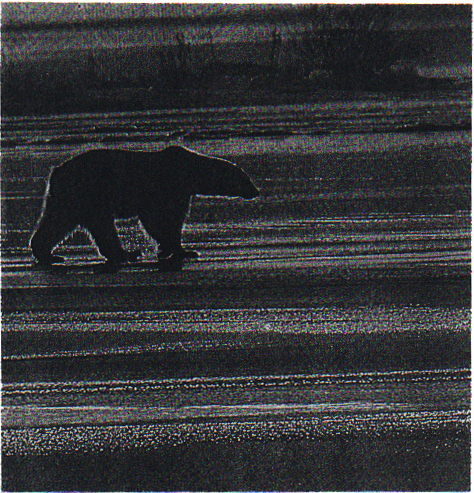 Marshall
Cultural Atlas Marshall
Cultural Atlas
This collection of student work is from
Frank Keim's classes. He has wanted to share these works for others
to use as an example of Culturally-based curriculum and documentation. These
documents have been OCR-scanned. These are available
for educational use only.


Polar Bear
Polar bears (Ursus maritimus) live mostly in the far North around
the Arctic Ocean, in Alaska, Canada, Greenland and Siberia. Their
favorite hunting grounds are on the edge of the Arctic ice pack.
Their usual prey consists mostly of sea animals like fish, seals
and walruses, but if they are really hungry they may go to a dump
area and look for food.
Polar bears are the best swimmers of all the bears because they do
more swimming in the winter while the other bears are sleeping in
their dens. They can swim up to 6 miles an hour. Although Polar bears
are big in size, they can run very fast. A Polar bear can run up to
25 miles an hour. They can even keep up with a reindeer. Polar bears
have smaller heads and longer necks than Brown bears. They also have
a slender body to help them swim faster and easier. A fully grown
Polar bear weighs up to 1600 pounds and is nine and a half feet long.
The fur coat on Polar bears helps them keep warm through the cold
winter. The color of their coat is white with a yellow tinge.
Mother Polar bears can have up to two cubs a year. The cubs weigh
up to one pound. They stay with their mother till they can live on
their own and eat on their own. They stay up to 2 years with their
mother so they can learn how to hunt and survive on their own Most of
the time the males don't go into dens, but the females do because
they have to give birth to the cubs. The males hunt most of the time
and it is dangerous for the young cubs if the male finds them. The
cubs would be eaten by the male and the mother could be hurt in a
fight.
Up until 1972 Polar bear hides were very valuable. Hunters killed
the bear just for the hide. Oil company employees also destroyed the
homes of Polar bears. By 1973, Polar bears became threatened and
Canada, Russia, and the United States had to sign an agreement
prohibiting most sport hunting.
By:Tina Papp
Bear Fire
Stories and Poems
about Bears
|
by Marshall High School
Language Arts Classes
Spring, 1992
Produced
by
Information
about Bears
Creative
Stories from the Imagination
True
Stories from Experience
Poems
Christmastime Tales
Stories real and imaginary about Christmas, Slavik, and the New Year
Winter, 1996 |
Christmastime Tales II
Stories about Christmas, Slavik, and the New Year
Winter, 1998 |
Christmastime Tales III
Stories about Christmas, Slavik, and the New Year
Winter, 2000 |
| Summer Time Tails 1992 |
Summertime Tails II 1993 |
Summertime Tails III |
| Summertime Tails IV Fall, 1995 |
Summertime Tails V Fall, 1996 |
Summertime Tails VI Fall, 1997 |
| Summertime Tails VII Fall, 1999 |
Signs of the Times November 1996 |
Creative Stories From Creative Imaginations |
| Mustang Mind Manglers - Stories of the Far Out,
the Frightening and the Fantastic 1993 |
Yupik Gourmet - A Book of
Recipes |
|
| M&M Monthly |
|
|
| Happy Moose Hunting! September Edition 1997 |
Happy Easter! March/April 1998 |
Merry Christmas December Edition 1997 |
| Happy Valentine’s
Day! February Edition
1998 |
Happy Easter! March/April Edition 2000 |
Happy Thanksgiving Nov. Edition, 1997 |
| Happy Halloween October 1997 Edition |
Edible and Useful Plants of Scammon
Bay |
Edible Plants of Hooper Bay 1981 |
| The Flowers of Scammon Bay Alaska |
Poems of Hooper Bay |
Scammon Bay (Upward Bound Students) |
| Family Trees and the Buzzy Lord |
It takes a Village - A guide for parents May 1997 |
People in Our Community |
| Buildings and Personalities of
Marshall |
Marshall Village PROFILE |
Qigeckalleq Pellullermeng ‘A
Glimpse of the Past’ |
| Raven’s
Stories Spring 1995 |
Bird Stories from Scammon Bay |
The Sea Around Us |
| Ellamyua - The Great Weather - Stories about the
Weather Spring 1996 |
Moose Fire - Stories and Poems about Moose November,
1998 |
Bears Bees and Bald Eagles Winter 1992-1993 |
| Fish Fire and Water - Stories about fish, global warming
and the future November, 1997 |
Wolf Fire - Stories and Poems about Wolves |
Bear Fire - Stories and Poems about Bears Spring,
1992 |
|